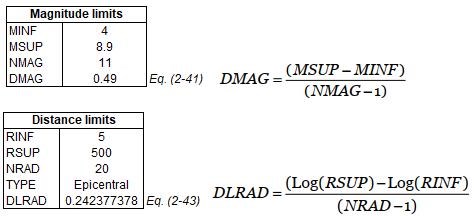Dear Marisella,
Next, you may find a step-by-step process you should follow to build the attenuation table corresponding to your model:
1. Calculate DMAG and DLRAD using equations 2-41 and 2-43:

2. Define the k's bins for magnitude and distance: according to your information, there are 11 and 20 bins for magnitude and distance, respectively. Using equation 2-40 (for magnitude) and 2-42, (for distance), their bins can be determined. In both equations, k refers to the bin you are defining; for instance, in your model, k_magnitude is from 1 to 11, and k_distance is from 1 to 20. Since your model depends of distance (R), not log(R), you have to apply the antilog (exponential) to the distance bins previously determined. Note that for k=1, the magnitude and distance bins correspond to the lower limit of magnitude and distance, respectively, likewise, for k=11 (magnitude) and k=20 (magnitude) the bins correspond to the upper limit of magnitude and distance, respectively.

3. Calculate the intensity for each magnitude-distance pair using the equation of your model:

4. Repeat step 3 for each spectral period. If your model was defined only for PGA, the attenuation table is done.
5. Copy results to a text file and make sure they do not have funny characters between them. Remember to save the file with extension .atn

I hope this helps you to build your attenuation table.
If this attenuation model is published in any report/article, please share with us its reference and maybe in further versions it will be included as an built-in model.
Do not hesitate to contact us if you have other questions about this subject.
Thank you for your preference and interest in R-CRISIS.
Best regards,













